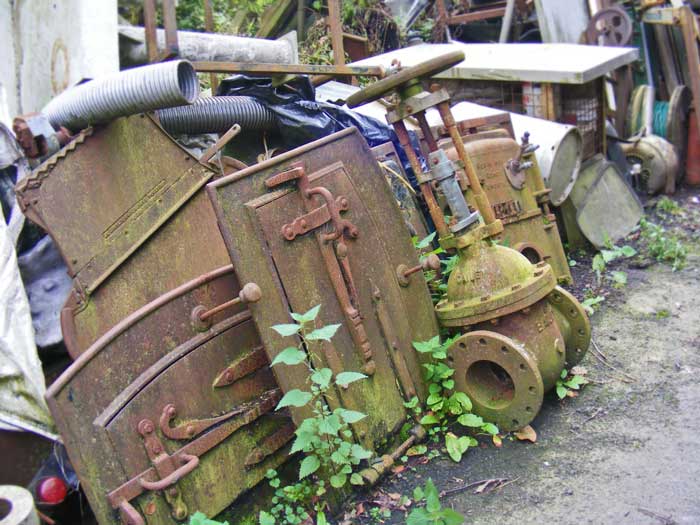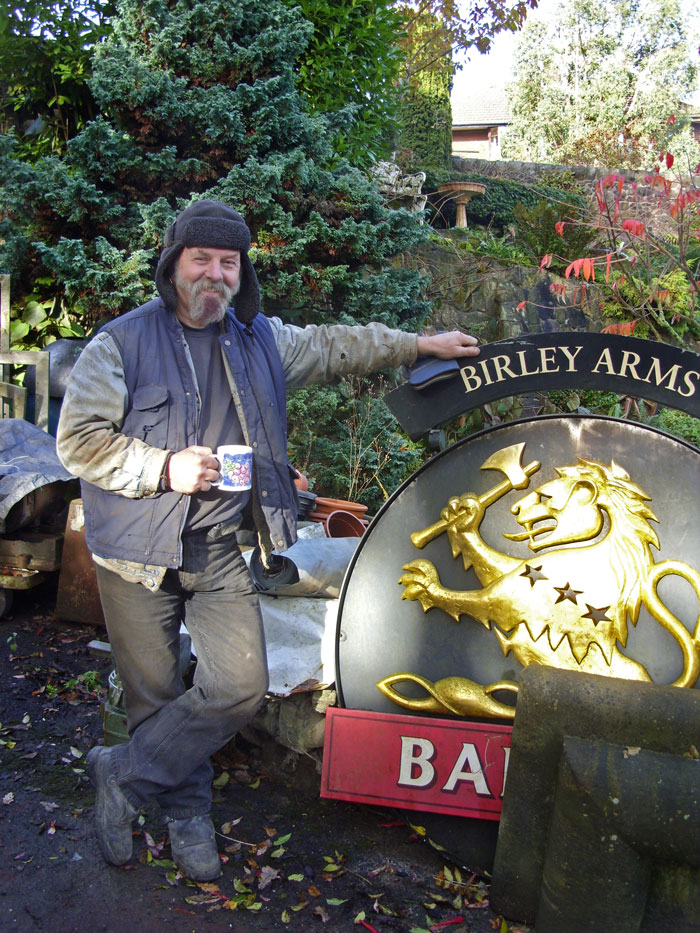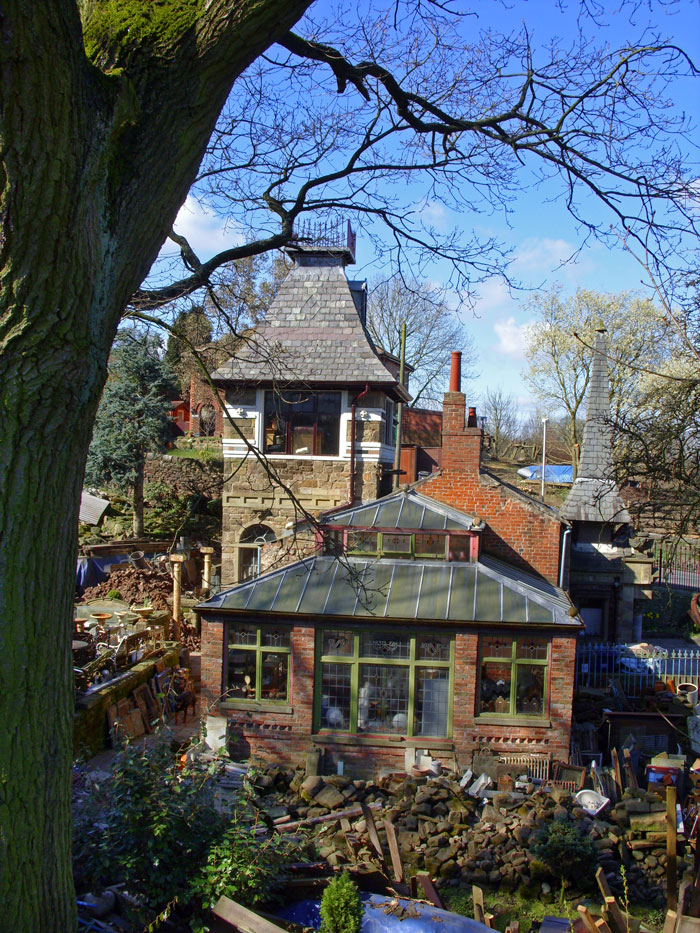
The Lancashire Salvager: The Weird World Of Eddie Whiteside
by Northern Life
On the southern fringe of the city of Preston lies the old cotton spinning village of Higher Walton dominated by the striking red-brick cotton mill and tall square chimney. Half way up steep Kittlingborne Brow – “brow or brew” – in Old Lancashire speak means – ‘a steep hill’ – is the impressive home of Eddie Whiteside, Lancashire’s very own Salvager.
The front aspect of Eddie’s house which enjoys a panoramic view of the village is most impressive. There is a large ornamental stone and brick porch clearly constructed from recycled materials on top of which dramatically rises the bizarre spectacle of a huge, grey slated church spire.
 The huge porch dominates the house which was originally a pair of late 18th century cotton operatives’ dwellings, built to the local vernacular design. To the front there is a small flagged forecourt, protected from the pavement by impressive wrought iron railings salvaged from a Lancashire cotton mill. As a reminder of Lancashire’s former mill engineering prowess, there is a massive cast-iron gear-wheel and crank-shaft that was rescued from a demolished Lancaster Mill. Contentedly growing around a jumble of yesteryear’s miscellanea – all salvaged, recovered and rescued from demolition sites ranging all over the North West – are a host of rose bushes and shrubs.
The huge porch dominates the house which was originally a pair of late 18th century cotton operatives’ dwellings, built to the local vernacular design. To the front there is a small flagged forecourt, protected from the pavement by impressive wrought iron railings salvaged from a Lancashire cotton mill. As a reminder of Lancashire’s former mill engineering prowess, there is a massive cast-iron gear-wheel and crank-shaft that was rescued from a demolished Lancaster Mill. Contentedly growing around a jumble of yesteryear’s miscellanea – all salvaged, recovered and rescued from demolition sites ranging all over the North West – are a host of rose bushes and shrubs.
It was a beautiful sunny morning when I parked my truck on the ‘double yellows’ outside the home of my good friend Eddie, who is undoubtedly one of Lancashire’s most interesting, friendly and hospitable characters. Glancing out of the passenger’s window, I noticed Eddie standing awaiting my arrival at the front gate, his shaven pate gleaming in the sunlight, his three large gold earrings dangling from his extended earlobes, and, with his purple-hued, greying beard bobbing up and down. “Hiya Alan – you’ve landed!” Eddie cheerfully exclaimed. “You’d better shift your van or you’ll be nicked by the Yeller Peril. Drive up t’road, I’ll open th’ yard gates”.
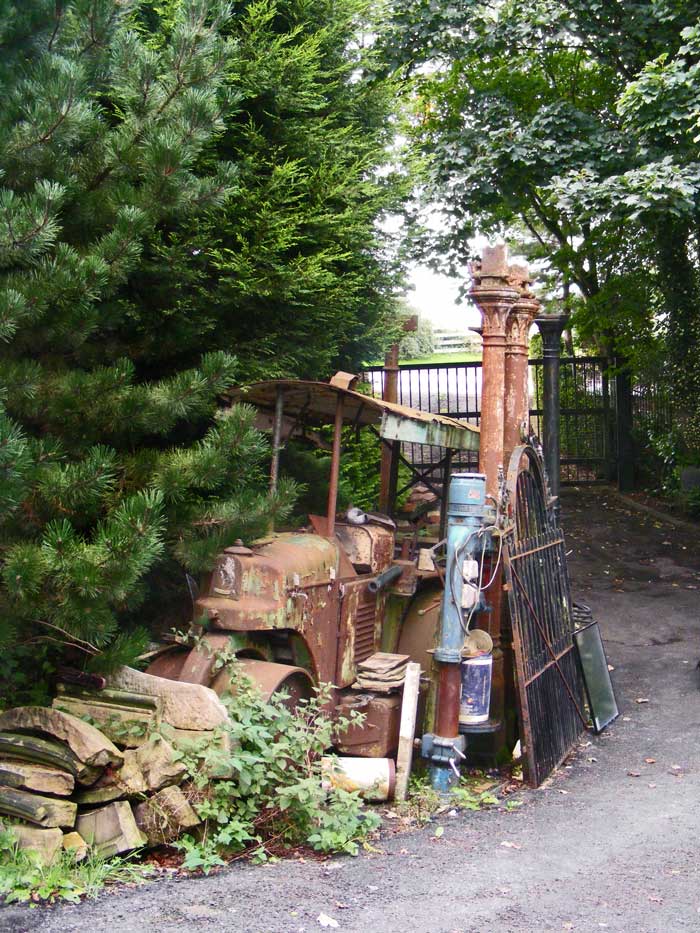 Arriving at the massive iron gates located up the Brow, I patiently awaited the arrival of Eddie to unlock the two gates which wouldn’t have looked out of place guarding Clitheroe Castle. After the grating rasp of a significant number of large iron bolts being drawn, the huge gates were thrown open, and the Lancashire Salvager, with a welcoming smile, bade me enter his domain. After carefully negotiating my van into the tight confines of the upper yard containing a mountainous heap of old beer barrels, stacks of mill flag stones, ancient cast-iron street lamp posts and huge piles of salvaged timbers and bricks, I shook hands with Eddie who as ever was surrounded with a small pack of huge black Rottweillers, all of which vied to win favours from their beloved master. Eddie, lovingly patted the dogs’ huge heads while offering up his gaudily tattooed arms for his canine friends to nuzzle against. “You’ll be awreet Alan, they’ll not eat you, but stick close by me,” he said assuringly. I just looked towards each of the massive dogs with rising anxiety. Even though I regularly visited Eddie, I certainly wouldn’t like to attempt to trespass onto his property alone.
Arriving at the massive iron gates located up the Brow, I patiently awaited the arrival of Eddie to unlock the two gates which wouldn’t have looked out of place guarding Clitheroe Castle. After the grating rasp of a significant number of large iron bolts being drawn, the huge gates were thrown open, and the Lancashire Salvager, with a welcoming smile, bade me enter his domain. After carefully negotiating my van into the tight confines of the upper yard containing a mountainous heap of old beer barrels, stacks of mill flag stones, ancient cast-iron street lamp posts and huge piles of salvaged timbers and bricks, I shook hands with Eddie who as ever was surrounded with a small pack of huge black Rottweillers, all of which vied to win favours from their beloved master. Eddie, lovingly patted the dogs’ huge heads while offering up his gaudily tattooed arms for his canine friends to nuzzle against. “You’ll be awreet Alan, they’ll not eat you, but stick close by me,” he said assuringly. I just looked towards each of the massive dogs with rising anxiety. Even though I regularly visited Eddie, I certainly wouldn’t like to attempt to trespass onto his property alone.
He is somewhat of a philosopher; a deep-thinking man
From the top of the Yard, the vista before my eyes comprised a mountainous Steptoe–esqe accumulation of vintage machinery and engineering equipment, rusty old tools and broken down old commercial vehicles. Walking down the narrow path we came to Eddie’s brick workshop together with several smaller attendant buildings which served as weather-beaten repositories for the million and one fascinating smaller artefacts and bygones stored within. Eddie explained that the concrete beams forming the workshop floor were salvaged from Orr’s Mill in nearby Bamber Bridge.
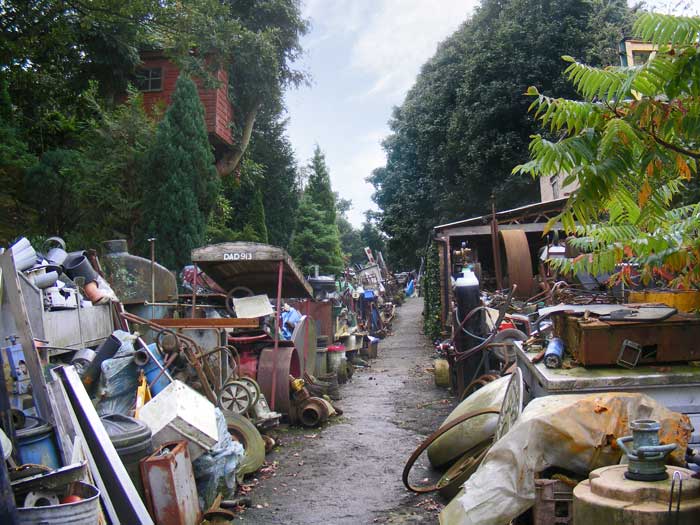 We continued walking amidst this Aladdin’s cave of salvaged treasure which led down to the rear of Eddie’s beloved home, to its attendant, imposing, square-built building known as the Tower. Passing an old 1970s caravan on the left the door suddenly opened and out popped Eddie’s son, Shane. “Hi Alan, would you like a brew?” inquired the pleasant looking blonde haired young chap. “Aye, a mug o’tea Shane.” Eddie pointed to a jumbled heap of square terracotta floor tiles. “When you’ve brewed, I want ye to fettle yon tiles.” He instructed young Shane.
We continued walking amidst this Aladdin’s cave of salvaged treasure which led down to the rear of Eddie’s beloved home, to its attendant, imposing, square-built building known as the Tower. Passing an old 1970s caravan on the left the door suddenly opened and out popped Eddie’s son, Shane. “Hi Alan, would you like a brew?” inquired the pleasant looking blonde haired young chap. “Aye, a mug o’tea Shane.” Eddie pointed to a jumbled heap of square terracotta floor tiles. “When you’ve brewed, I want ye to fettle yon tiles.” He instructed young Shane.
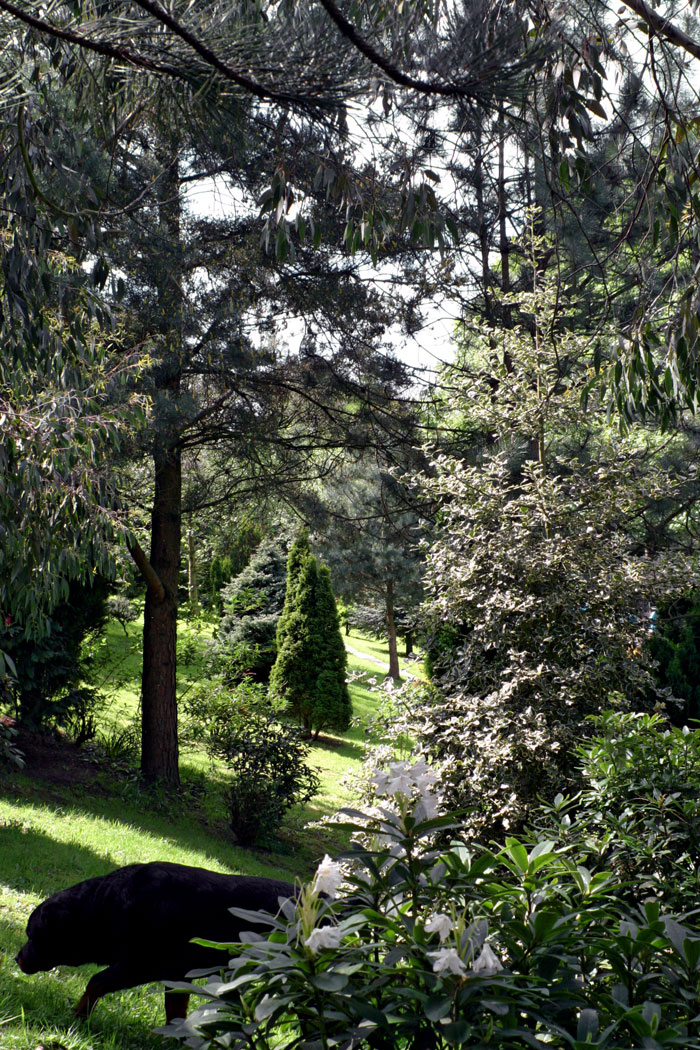 While awaiting the brew, my gaze wondered up to the right. Here the land steeply rises up to a well trimmed Hawthorn hedge, with meadow land beyond. The view up and along the hillside is that of a beautifully cared for and extensive collection of rhododendrons, eucalyptus, laurels, yew and breathtaking, colourful varieties of deciduous and evergreen shrubs.
While awaiting the brew, my gaze wondered up to the right. Here the land steeply rises up to a well trimmed Hawthorn hedge, with meadow land beyond. The view up and along the hillside is that of a beautifully cared for and extensive collection of rhododendrons, eucalyptus, laurels, yew and breathtaking, colourful varieties of deciduous and evergreen shrubs.
This attractive collection of trees and shrubs originated from old cotton mill office gardens, beer gardens belonging to ancient inns and a multitude of other locations from all over Lancashire threatened by demolition. Eddie accompanied by his son Shane and daughter Sharlene, have for years, upon receiving tip-offs from mates of Eddie’s in the demolition game, spent countless hours digging up shrubs and small trees that have been in danger of being bulldozed into the ground. On returning home the family painstakingly and lovingly planted the bushes. Now, years later the fruits of their labours are a joy to behold.
Eddie and I plonked ourselves down onto an old cast-iron ale house bench over-looking the huge garden pond which Eddie had dug by hand some thirty years earlier out of the stubborn Lancashire clay. Eddie is indeed quite a complex character: a colourful, hard-working, physically strong chap whose background was in maintenance engineering. An engineering craftsman who possessed well-polished skills for working in a wide variety of materials whether metal, stone, brick, lead, wood and even stained glass. Eddie is extremely passionate in regard to salvaging, renovating and repurposing all sorts of artefacts, manufactured by British craftsmen in a world now gone for good. This world was where Britain had an unrivalled and renowned reputation for design and manufacture of a multitude of products. Eddie’s life revolves around his home, his family and his dogs. He is also somewhat of a philosopher; a deep-thinking man who enjoys reading, indeed he has many thousands of old books stored in the top of the Tower.
Eddie explained with relish, he was a man who enjoyed the ups and the downs of life
Eddie had progressed with the construction of his huge 55-foot long, by 30-foot wide, three storeys tall ‘Man Cave’. I knew from my previous visits that this building was already chock full of Eddie’s ‘quality stock’. While musing on his profound achievements in the ‘world of salvage’, my eyes alighted on the most attractive stained glass and brickbuilt conservatory that years earlier, Eddie had constructed from salvaged materials and graces the gable-end of the house. Stacked all around the west aspect was a bewildering mishmash of cast-iron busts depicting horses heads, a Roman centurion, an array of decorative iron urns, cast-iron columns, marble pillars, carved date stones from old cotton mills, cast-iron fireplaces, decorative castiron radiators, sandstone and marble benches, a love seat of ancient Welsh slate, a rusty iron wheelbarrow, a heap of cast-iron Lancashire loom cogwheels, an ornamented cast-iron fountain; etc…
Eddie came out of the back of the house carrying in one hand two ironstone mugs of what turned out to be scalding, strong coffee. Eddie explained with relish, he was a man who enjoyed the ups and the downs of life; that despite attaining the advanced age of 67, he was as agile as a Springbok. And, although a Lancashire lad by upbringing, had been born a Scotsman, in Dunfermline, Fife.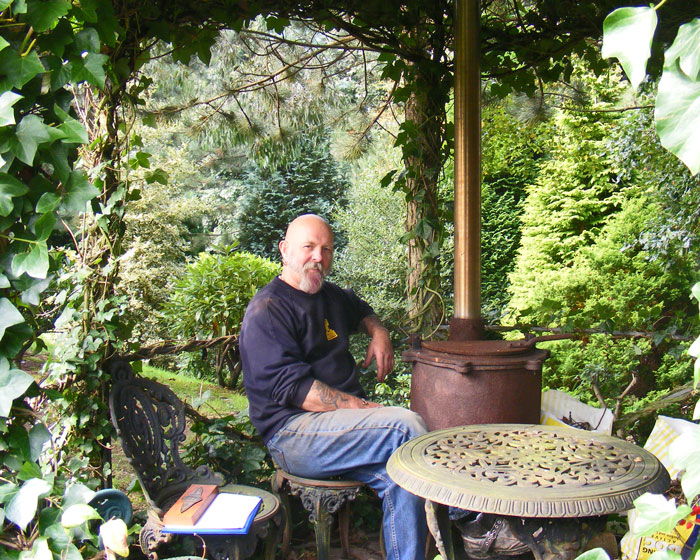
Eddie motioned for me to follow him into the house via the substantial and most attractive glazed doubledoor at the base of the Tower. Following him through the doors, my eyes flitted from one weird and interesting artefact to another, a marble plaque depicting a female head, to a tall stone statue that graced the room fantastically. “Alan, what do you think of these bonny panels?” Eddie questioned, whilst pointing to a stack of ancient beautifully carved oak panelling stacked against a wall. “I’ve just salvaged these oak panels from the offices of a Rossendale shoe factory.” “Fantastic,” I enthusiastically replied. We entered the low-ceilinged living room of the house via the wooden door which sported beautiful stained-glass panels of red Lancastrian roses. He had previously told me he had salvaged these from a Preston pub receiving the ‘big hammer treatment’.
Eddie switched on three standard lamps, which had large, colourful art-deco glass lamp shades, and the room sparkled, the light dancing off his collection of antique bottles that adorned the shelves of a massive old dresser and a row of old brass plaques nailed to a gigantic beam running across the ceiling. All over the fascinating room were collections of old ceramic pots and Toby jugs. Fastened to more beams was a collection of military knives and bayonets. Glancing beneath a large armchair, I almost jumped out of my skin, for on the floor was two rows of human skulls which were festooned with huge black, multi-legged spiders, “You’re alreet Alan, them beggars arn’t real ‘uns. I got ’em for a Halloween party. Me central heating boiler’s is keeping us good and warm.” said Eddie, pointing towards the six foot tall, three-foot diameter cylindrical, riveted boiler of ancient origin that was mounted upon a square brass-bound, iron box which acted as the ash-pit.
“You’ve had yon wood-burning boiler providing heat for several years now.” I exhorted, moving closer to the red oxide painted boiler set against the random stone wall at the gable end of the room.
“The bugger burns scrap wood which heats the room and the whole house brilliantly. We’ve plenty of piping hot water for baths,” he grinned.
During his twenties Eddie enjoyed working on the highly acclaimed and profoundly exciting ‘wild mouse’ ride
Eddie had previously related that when he was aged around six-years old, his parents moved from Fife down to Lytham on the Lancashire coast. His early life was devoid of comforts, and luxuries were unheard of. He lived with his family in a small top floor apartment. Water for drinking, bathing and laundering had to be carted up from the ground floor of the apartment block and the toilet was downstairs also. Later, the Whiteside family moved into a small semi
located at South Shore, Blackpool. Eddie left school at 15; he had been top in his final year in metalwork and technical drawing. All good disciplines for his future life as an engineer and Master Salvager. He obtained an apprenticeship as a turner/fitter at a well renowned firm of Blackpool mechanical engineers where he obtained a great deal of technical and practical knowledge. Because he was passionate about his chosen career and was naturally intelligent and adept practically, he found the engineering work most satisfying.
After qualifying, Eddie took a diverse number of jobs at general engineering firms which included a short enjoyable spell as a maintenance team member who looked after the impressive iron structure of Blackpool Tower. He had a good head for heights and he soon became experienced in climbing whilst painting the ironwork of the 518 feet tall Victorian built Tower. The team of engineers and painters christened Blackpool Tower ‘the Stick’ and Eddie thoroughly enjoyed working with his mates, albeit that many of the jobs were quite terrifying to execute. One of the many ‘bonuses’ the maintenance team enjoyed was collecting handfuls of coins from the rainwater gutters on the roof of the Winter Gardens. Apparently, the visitors used to drop the coins onto the glass windows from high up on the viewing balconies on the Tower, in the hope of breaking the glass.
During his twenties Eddie enjoyed working as a maintenance engineer at the famous Blackpool Pleasure Beach. Whilst employed there, one of his favourite jobs was greasing, oiling and carrying out general engineering maintenance on the highly acclaimed and profoundly exciting ‘Wild Mouse’ ride.
Eddie moved from Blackpool to Higher Walton around 40 years ago. Overtime he converted the pair of original tiny brick cottages by knocking them into one large dwelling. In more recent times, he constructed the impressive front porch, complete with the church spire and at the rear of the property built the 40-feet high Tower and the beautiful, stained glass windowed conservatory.
Eddie’s life, it can be said, is immensely satisfying. For he has carved out his ‘special’ – although some would say, ‘bizarre’ lifestyle from utilising his significant general engineering and constructional skills and indeed his passion for salvage. He is proficient in all forms of ‘metal bashing’ – as he calls sheet metalwork and welding. He is equally skilled in woodworking and joinery, building work involving cutting and shaping stone, marble, brick and slate; bricklaying, slating, rendering etc.
Thus, after chilling out with my old friend the Lancashire Salvager, I then drove back through the large yard gates out into the ‘normal world’. Several miles nearer to Blackburn, after parking my van, I fished into the breast pocket of my jacket for a business card that my old friend had dropped in. Pulling out the small, white card, I read with amusement and profound
respect the red-printed wording:
Yes, indeed I mused, my friend Eddie Whiteside is certainly a most interesting and colourful character.
Alan is the author of Fred Dibnah’s Chimney Drops, Historic Steam Boiler Explosions, Jaggermens’ Bridges on Packhorse Trails and Rivet Lad. For more information and to order a book go to sledgehammerengineeringpress.co.uk


